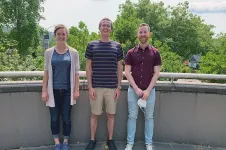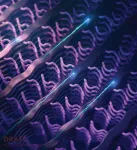(Press-News.org) Researchers have devised a way to multiply by more than ten-fold the accessible details of gene activity in individual cells. It's a big leap in the effort to understand cancer development, brain function, immunity and other biological processes driven by the complex interactions of multitudes of different cell types.
Organs and tissues are made up of cells that may look the same, but individual cells can actually differ dramatically. Single-cell analysis allows the study of this cell-to-cell variation within an organ, tissue or cancerous tumor. But the research has been hampered by limits on the depth of information that can be gleaned at the single-cell level when working with large numbers of cells.
"The downside has been the low-quality of single-cell profiles. Our method allows us to get a much more complete profile of any given single cell," said Andrew Adey, Ph.D., senior author of a paper in Nature Biotechnology describing the innovation. Adey is an associate professor of molecular and medical genetics in the OHSU School of Medicine.
He said the new method delivers about a ten-fold improvement in the amount of DNA that can be recovered from a single cell to be sequenced and interpreted. The genetic code is written in DNA in a sequence of units, called bases, that are like letters of an alphabet. Sequencing DNA reveals the order of the bases, and it is the first step to understanding the genetic makeup of a cell and whether particular genes are active or silent.
Single-cell studies are particularly important in understanding cancer. The cells of a tumor can be strikingly diverse. Different cells pick up different DNA mutations as the tumor grows, and some of the mutations and changes in gene activity give rise to sub-populations of tumor cells with new qualities, such as the ability to spread to other body parts or resist anti-cancer drugs.
Adey and colleagues showed that their method can be used to reveal DNA alterations that have emerged in a subset of cells in tumor samples taken from patients with pancreatic cancer. That's important because it can help researchers understand how populations of tumor cells evolve and become deadly.
"For example, you can potentially identify rare cell subtypes within a tumor that are resistant to therapy," Adey said. His team has already begun working with OHSU Knight Cancer Institute researchers testing the single-cell method as a way find out if some of the cells in a patient's tumor have evolved resistance to a particular chemo drug or targeted therapy. That knowledge could be used to develop individualized treatment plans for patients.
"If you are working with something like a cancer biopsy from a patient, a very small piece of tissue, you really want to make every cell count, you really have to get a lot of info from each single cell," Adey said.
The new method builds on a technique called single-cell combinatorial indexed sequencing, which Adey and colleagues developed earlier. It's a way to generate DNA libraries - collections of DNA fragments that can be used to analyze genes and mutations - for thousands of single cells at the same time. The process uses an enzymatic reaction to attach primers to the ends of the DNA fragments. "They are kind of like handles the sequencer uses to start reading," Adey says.
While the technique greatly increases the number of single cells that can be analyzed in one experiment, it comes with the tradeoff of sparse coverage of readable DNA sequences per cell. To be readable, a primer must be attached at both ends of the DNA fragment, which the reaction accomplishes only half of the time.
The new method results in all library fragments having primers on both ends, while also improving efficiency in other ways. The researchers said the efficiency has the added benefit of reducing sequencing costs by about one third.
The adapters are designed such that standard sequencing recipes can be used instead of the custom workflows and primers that are required for competing methods. That makes the method compatible with many different tests commonly used to explore the state of single cells.
"This chemistry can just slot into many other assays," Adey said. "People can just start using it."
INFORMATION:
This research was supported by the National Institutes of Health (grants R01DA047237, R35GM124704, and R01MH113926).
In our interest of ensuring the integrity of our research and as part of our commitment to public transparency, OHSU actively regulates, tracks and manages relationships that our researchers may hold with entities outside of OHSU. In regards to this research, Andrew Adey and OHSU colleague Ryan M. Mulqueen are authors on licensed patents that cover components of the technologies described here. Review details of OHSU's conflict of interest program to find out more about how we manage these business relationships.
Most of us are familiar with the fact that women live longer than men. But fellas, if we told you there was one thing that could be done to increase your lifespan, would you do it?
In a study published today in eLife , University of Otago researchers along with collaborators from the United States, have shown that castration of male sheep delays aging of DNA compared to intact males, and that it also drives feminine characteristics of DNA and the chemical tags it holds, known as DNA methylation.
"Both farmers and scientists have known for some time that castrated male sheep live on average much longer than their intact counterparts; however, this is ...
Three mutations in the Epsilon coronavirus spike protein dampen the neutralizing potency of antibodies induced by current vaccines or past COVID infections.
The mutations give this coronavirus variant of concern a means to totally evade specific monoclonal antibodies used in clinics and reduce the effectiveness of antibodies from the plasma of vaccinated people.
To better understand the exact immune escape strategies at work here, the scientists visualized this variant's infection machinery to see what is different from the original configuration of the pandemic coronavirus, and what the implications of these changes are.
The international project was led by David Veesler's lab in the Department of Biochemistry at the University of Washington ...
In a retrospective, multi-centre cohort study conducted by researchers from Nanjing University, Huazhong University of Science and Technology, Jinling Hospital and the Second Hospital of Nanjing, a microRNA-like small RNA encoded by SARS-CoV-2 was identified in the serum of COVID-19 patients, which can be developed as a non-invasive biomarker for stratification of severe patients from mild/moderate ones and for identification of high-risk individuals before clinical manifestation of severe symptoms. This biomarker ensures proper allocation of patients to different ...
A research team, led by Professor Dai-Sik Kim in the Department of Physics at UNIST has developed a new technique of predefining the crack pattern on a flexible substrate by a sequential deposition of metallic layers which leads to a formation of a "zero-nanometer gap, or a "zerogap," between the adjacent lateral patterns.
These gaps, according to the research team, readily open and recover with gentle bending and relaxing of the flexible substrate, precisely along the rims of the pre-patterns of centimeter lengths. Furthermore, in a prototypical pattern of densely packed slit arrays, these gaps serve as antennas achieving transparency for polarizations perpendicular to the length of the gap when opened ...
Chemical elements make up pretty much everything in the physical world. As of 2016, we know of 118 elements, all of which can be found categorized in the famous periodic table that hangs in every chemistry lab and classroom.
Each element in the periodic table appears as a one-, two-letter abbreviation (e.g. O for oxygen, Al for aluminum) along with its atomic number, which shows how many protons there are in the element's nucleus. The number of protons is enormously important, as it also determines how many electrons orbit the nucleus, which essentially makes the element what it is and gives it its chemical properties. In short, the atomic number is an element's ID card.
The periodic table ...
A new organic (carbon-based) semiconducting material has been developed that outperforms existing options for building the next generation of biosensors. An international research team led by KAUST is the first to overcome some critical challenges in developing this polymer.
Much research effort is currently expended into novel types of biosensors that interact directly with the body to detect key biochemicals and serve as indicators of health and disease.
"For a sensor to be compatible with the body, we need to use soft organic materials with ...
Networks of ground-based sensors paired with airborne drones could give firefighters a critical edge when battling wildfires, KAUST researchers have found. The sensor/unmanned aerial vehicle (UAV) network could significantly shorten the time taken to detect a wildfire, giving firefighters a better chance to contain the fire before it grows too large to control.
Wildfire detection is currently performed mainly by satellite imaging and remote cameras, but these technologies can be impeded by cloudy weather and fires can grow to a considerable size before they are spotted. With the recent significant global ...
The surprising results of a decade-long investigation by Alessandro Vezzosi and Agnese Sabato provide a strong basis for advancing a project researching Leonardo da Vinci's DNA.
Their extensive study, published by the journal "Human Evolution" (Pontecorboli Editore, Florence), documents with new certainty the continuous male line, from father to son, of the Da Vinci family (later Vinci), from progenitor Michele (born 1331) to grandson Leonardo (6th generation, born 1452) through to today -- 21 generations in all, including five family branches -- and identifies 14 living descendants.
The work fills gaps and corrects errors in previous genealogical research into Leonardo's family, while ...
A new study shows how urbanisation has influenced anthropogenic CO2 and air pollutant emissions across all world regions, by making use of the latest developments in the Emissions Database for Global Atmospheric Research (EDGAR, https://edgar.jrc.ec.europa.eu/) developed by the Joint Research Centre of the European Commission. The results show that by 2015 urban centres were the source of a third of global anthropogenic greenhouse gases, and the majority of air pollutant emissions.
The authors, from institutions in France and Italy, used the EDGAR database to provide a country-to-global ...
Researchers at Karolinska Institutet in Sweden publish new findings in the journal Cancer Discovery showing how pharmacological activation of the protein p53 boosts the immune response against tumours. The results can be of significance to the development of new combination therapies that will give more cancer patients access to immunotherapy.
Given its ability to react to damage to cellular DNA and the key part it is thought to play in preventing tumour growth, the protein p53 has been dubbed the "guardian of the genome". Half of all tumours have mutations in the gene that codes for the protein, and in many other tumours, p53 is disabled by another protein, MDM2.
It has long been known ...




